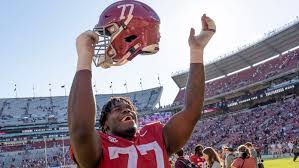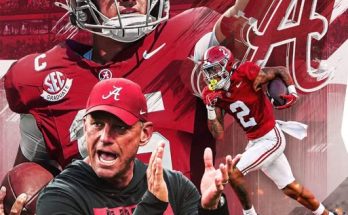The Alabama Crimson Tide have long been synonymous with dominant defensive play, and as the summer of 2025 rolls on, all eyes are on whether this year’s defensive line unit can recapture the terrorizing form that once defined the Nick Saban era. Now under the leadership of head coach Kalen DeBoer, the Crimson Tide are searching for an identity on the defensive front that can elevate them back to national championship contention. With a mix of returning veterans, rising stars, and a few new transfers, the question remains: will Alabama’s defensive line take the leap needed to lead the SEC and the nation?
Few position groups carry more pressure in Tuscaloosa than the defensive line. It’s the bedrock of what made Alabama’s defense elite for over a decade, creating chaos in the backfield and dictating the tempo at the line of scrimmage. But in recent years, the group has lacked the kind of star-studded consistency Alabama fans grew used to. While the 2024 defense held its own, it didn’t feature the kind of dominant line play that used to define the Tide. Enter 2025, and the potential for a resurgence feels real.
One of the biggest reasons for optimism is the continued development of junior defensive end Jaheim Oatis, who has emerged as the vocal and physical leader of the unit. Oatis, who tips the scales at 6-foot-5 and nearly 320 pounds, spent the offseason refining his technique and dropping body fat to improve his mobility. Coaches and teammates have praised his commitment to conditioning and film study, and many around the program believe he could be on the verge of a breakout All-American campaign. His ability to clog up interior gaps while still flashing pass-rush ability makes him the kind of anchor DeBoer and defensive coordinator Kane Wommack can build around.
Joining Oatis as a cornerstone is rising sophomore James Smith, a former five-star recruit who flashed potential in limited snaps last year. Smith’s blend of quickness and violent hands drew comparisons to former Bama greats like Jonathan Allen and Quinnen Williams during spring ball. With another year in the strength and conditioning program, the coaching staff believes Smith could be an X-factor up front, especially in third-down situations where Alabama struggled to consistently collapse the pocket last season.
Then there’s the matter of depth—something Alabama’s line has sometimes lacked in recent seasons. That issue appears to be resolving itself, thanks in part to a strong 2024 recruiting class and some smart transfer portal work. The addition of Michigan State transfer Simeon Barrow Jr. brings instant experience and leadership. Barrow, who started over 30 games during his time in East Lansing, provides a rugged interior presence and is expected to contribute immediately. His SEC-ready frame and relentless motor give Alabama another weapon to throw at opposing offensive lines.
Redshirt sophomore Curtis Perry has also been generating buzz. A highly touted recruit in his own right, Perry has struggled with injuries early in his career but finally appears healthy. Coaches say his burst off the edge and improved discipline in run fits have stood out during summer practices. If he can stay healthy, Perry could give Alabama the kind of edge-setting presence that makes opposing quarterbacks uncomfortable.
Meanwhile, true freshman Zion Grady, one of the top defensive line recruits in the nation, has already started to turn heads. Grady’s raw athleticism is impossible to ignore, and while he still has room to grow mentally and physically, the coaching staff sees him as a future star. It wouldn’t be surprising to see him earn rotational snaps as early as Week 1.
But talent alone doesn’t win games in the SEC. Alabama’s defensive line will need to bring a level of toughness, discipline, and attention to detail that has occasionally waned during transition years. That’s where new defensive line coach Freddie Roach comes into play. Though not new to the Alabama program, Roach has taken a more hands-on role under DeBoer’s regime and has emphasized fundamentals, pad level, and violent hand usage in drills this summer. Players have responded well to his message, and insiders say the energy and focus in the position room has improved significantly.
Another critical component to the line’s potential leap forward is the scheme. Under Wommack, Alabama plans to use more hybrid fronts and creative pressure packages. Expect to see a mix of three-man and four-man looks, with the occasional linebacker or nickel corner blitz thrown in to keep offenses guessing. This versatility could be key, especially against modern spread offenses that demand adaptability and speed from defensive linemen. Players like Smith and Oatis give Alabama the flexibility to toggle between base and exotic fronts without sacrificing size or strength.
One area the Tide must improve is against the run. Last season, Alabama surrendered more than 140 rushing yards in several SEC contests, often allowing opposing backs to find daylight up the middle. That simply isn’t acceptable for a program with championship aspirations. Wommack has made stopping the run a summer priority, challenging the line to win early downs and force offenses into predictable passing situations. If Alabama can turn second-and-fives into second-and-nines, their improved depth and athleticism on the line could feast.
Pass rush is the other major area of emphasis. While the Tide generated sacks in spurts last season, they rarely created sustained pressure with just four linemen. This year’s group will be expected to win more one-on-one battles and collapse the pocket consistently. That could also be aided by improved secondary play, giving the line an extra second or two to get home. Still, DeBoer knows that if Alabama is going to compete with the likes of Georgia, Texas, and LSU, they’ll need their front to dominate.
The schedule won’t do them any favors. Early matchups against Wisconsin and Ole Miss will offer immediate tests, with both teams boasting veteran offensive lines and run-heavy schemes. Later in the season, Alabama will face the likes of Texas A\&M, LSU, and Georgia—all programs with elite trenches. If the Tide’s defensive line can hold its own against that gauntlet, it’ll speak volumes about their growth.
There’s also a leadership component to all of this. Alabama has often been at its best when its stars on the defensive line set the tone for the entire team. Think back to players like Da’Ron Payne, Marcell Dareus, or Raekwon Davis—men who not only made plays but held teammates accountable. That leadership torch seems to be passing to Jaheim Oatis, who has taken on a more vocal role in the locker room. Oatis has reportedly organized extra film sessions, weightlifting groups, and team-building activities for the position group. Those intangible qualities might be what ultimately push this defensive line over the top.
Still, questions remain. Can the Tide stay healthy in the trenches? Will young players like Grady and Perry avoid the typical growing pains? And will the scheme changes under Wommack translate from theory to execution? These are the unknowns that make this summer so pivotal. Every rep in the weight room, every snap in 7-on-7s, every film session could make the difference come October and November.
Fans, too, are watching closely. The Bama faithful have high expectations, and after falling just short of the College Football Playoff last season, there’s an air of urgency. Many believe that if the defense—particularly the front line—can elevate its play, Alabama could return to the sport’s pinnacle. The offense, led by returning quarterback Jalen Milroe and a talented skill group, is expected to be explosive. But it’s the defense—and especially the men in the trenches—that may hold the key to the Tide’s fate in 2025.
Recruiting continues to play a role as well. Alabama is in strong position with several top-100 defensive line prospects for the 2026 class, including five-star tackle Malik Hardy and edge rusher Kendall Tyson. A strong showing this fall could not only lift the Tide’s national title hopes but cement their status as the premier destination for elite defensive line talent once again.
In a sport increasingly defined by explosive plays and quick offenses, the importance of a dominant defensive line hasn’t diminished—it’s grown. The ability to control the line of scrimmage remains the most reliable path to victory. For Alabama, the pieces seem to be in place. Now it’s about putting it all together.
As summer workouts give way to fall camp and the countdown to kickoff accelerates, the Tide’s defensive line will be under a microscope. If they rise to the challenge, Alabama could not only contend in the SEC but reclaim its place as the nation’s most feared defense. If not, the path back to championship glory will be even steeper. Either way, the road to redemption starts in the trenches—and the Tide’s journey begins now.



